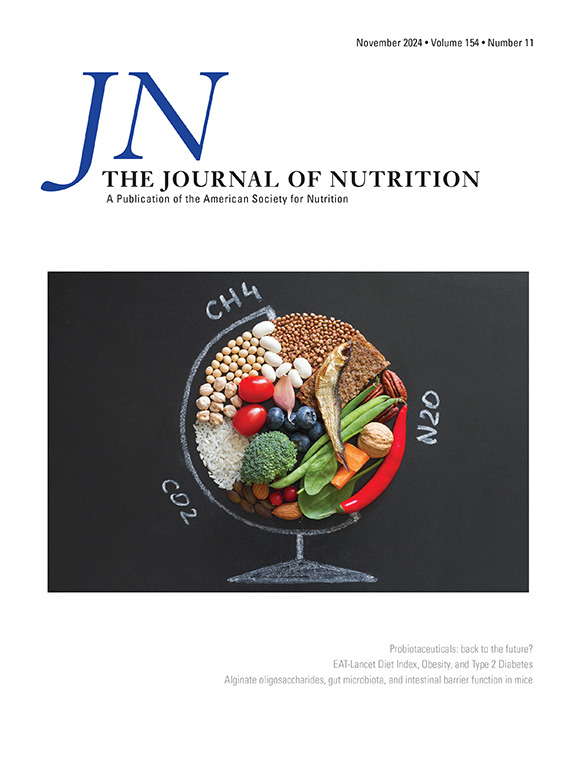在挪威母乳观察研究中,孕妇孕前体重指数与母乳脂肪酸和磷脂组成的关系。
IF 3.8
3区 医学
Q2 NUTRITION & DIETETICS
引用次数: 0
摘要
背景:人乳脂肪的品质取决于其脂肪酸(FA)和磷脂(PL)的组成。有明确的证据表明,母亲的饮食影响人乳FA组成。然而,关于孕前体重指数(pBMI)与牛奶FA和PL组成之间关系的科学文献仍然没有定论。目的:本观察性研究旨在确定母亲pBMI与牛奶FA和含胆碱PL物种组成之间的关系,考虑研究混杂因素,包括鱼类摄入量作为n3长链多不饱和FA (n3- lcpufa)的代理。方法:我们分别使用气相色谱法和流动注射质谱法分析了来自挪威母乳研究出生队列的628份牛奶样品中的总FA和含胆碱的dl类(溶血磷脂酰胆碱、磷脂酰胆碱和鞘磷脂)。多元回归分析评估pBMI与乳脂代谢产物(%FA, %PL)之间的关系(β =标准化回归系数,校正P值< 0.0005,B(95%置信区间[CI]) =非标准化系数,95% CI)。结果:产妇pBMI与n3-LCPUFA [β = -0.138, B(95%CI) = -0.010(-0.015, -0.005)]、n6/n3LCPUFA比值[β = 0.170, B(95%CI) = 0.020(0.012, 0.028)]、单不饱和脂肪酸[β = 0.207, B(95%CI) = 0.128(0.076, 0.180)]、相应的PL种[%LysoPC16:1, β = 0.171, B(95%CI) = 0.001(0.001,0.002)), %LysoPC18:1, β = 0.155, B(95%CI) = 0.005(0.002,0.007)]经研究协变量调整有显著相关性(P < 0.0005)。n6/n3 LCPUFA比值的pBMI解释的方差百分比为40%,n3 LCPUFA为34%,单不饱和脂肪酸为10%。相反,分析显示pBMI和含胆碱PL类别之间没有显著关联。结论:在pBMI≥30的母亲中,生物因素可能会增加硬脂酰辅酶a去饱和酶活性,降低脂蛋白脂肪酶活性,以及脂肪组织中非酯化FA的代偿性增加,这可能导致观察到的结果。代谢差异与BMI差异可能影响FA在乳腺甘油三酯和PL合成中的可用性。因此,除了饮食摄入外,保持健康的母亲pBMI可以改善母乳的营养质量,最终支持婴儿的发育。本文章由计算机程序翻译,如有差异,请以英文原文为准。
The Associations of Maternal Prepregnancy Body Mass Index With Human Milk Fatty Acid and Phospholipid Composition in the Observational Norwegian Human Milk Study
Background
Human milk fat quality depends on its fatty acid (FA) and phospholipid (PL) composition. There is clear evidence that maternal diet influences human milk FA composition. However, the scientific literature concerning associations between prepregnancy body mass index (pBMI) and milk FA and PL composition remains inconclusive.
Objectives
This observational study aimed to identify the associations between maternal pBMI and the milk FA and choline-containing PL species composition, considering study confounders, including fish intake as a proxy for n3 long-chain polyunsaturated FA (n3-LCPUFA).
Methods
We analyzed total FA and choline-containing PL-classes (lysophosphatidylcholine, phosphatidylcholine, and sphingomyelin) in 628 milk samples from the Norwegian Human Milk Study birth-cohort using gas chromatography and flow-injection mass spectrometry, respectively. Multiple regression analysis assessed the relationship between pBMI and milk lipid metabolites (%FA, %PL) (reported as β = standardized regression coefficient with adjusted P value < 0.0005, B(95% confidence interval [CI]) = unstandardized coefficient with 95% CI).
Results
Maternal pBMI showed significant association (P < 0.0005) with n3-LCPUFA [β = −0.138, B(95% CI) = −0.010 (−0.015, −0.005)], n6/n3LCPUFA ratio [β = 0.170, B(95% CI) = 0.020(0.012, 0.028)], monounsaturated FA [β = 0.207, B(95% CI) = 0.128(0.076, 0.180)], and corresponding PL species [%LysoPC16:1, β = 0.171, B(95% CI) = 0.001(0.001,0.002), %LysoPC18:1, β = 0.155, B(95%CI) = 0.005 (0.002,0.007)] adjusted with the study covariates. The percentages of variance explained by pBMI were 40% for the n6/n3 LCPUFA ratio, 34% for n3-LCPUFA, and 10% for monounsaturated FA. Conversely, analyses revealed no significant associations between pBMI and choline-containing PL classes.
Conclusions
Biological factors likely increased stearoyl-CoA desaturase activity, lower lipoprotein lipase activity, and a compensatory higher contribution of nonesterified FA from adipose tissue in mothers with pBMI ≥30 could potentially lead to the observed outcomes. Metabolic differences regarding BMI variances may influence the FA availability for mammary gland triglyceride and PL synthesis. Therefore, in addition to dietary intake, maintaining a healthy maternal pBMI may improve the nutritional quality of human milk, ultimately supporting infants’ development.
求助全文
通过发布文献求助,成功后即可免费获取论文全文。
去求助
来源期刊

Journal of Nutrition
医学-营养学
CiteScore
7.60
自引率
4.80%
发文量
260
审稿时长
39 days
期刊介绍:
The Journal of Nutrition (JN/J Nutr) publishes peer-reviewed original research papers covering all aspects of experimental nutrition in humans and other animal species; special articles such as reviews and biographies of prominent nutrition scientists; and issues, opinions, and commentaries on controversial issues in nutrition. Supplements are frequently published to provide extended discussion of topics of special interest.
 求助内容:
求助内容: 应助结果提醒方式:
应助结果提醒方式:


